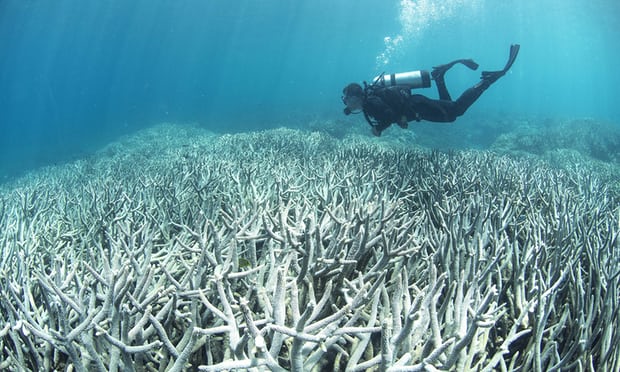The Barrier Reef is in danger – but it’s still one of the world’s great sights (culled from theguardian.com)
Anyone in the Cairns tourism industry who might be feeling a sense of panic about the largest destruction of coral on the Great Barrier Reef since divers first strapped on snorkels is not letting it show.
The north-eastern Australian city – a global holiday destination where the natural wonder’s name festoons everything from the signs greeting airport arrivals to the local casino – is celebrating a storming tourist trade over the last 12 months.
Nearly three million people visited in the year ending 31 March, according to Tourism Tropical North Queensland, including an 11% bump in overseas visitors to 830,000 and a 33.5% surge in domestic tourists.
However, chief executive Alex de Waal says this “extraordinary” spike would have been even bigger had it not coincided with global publicity about the deteriorating state of the reef. The reef has been in the media as never before over the past year because the coral is in mortal danger. Bleaching caused by climate change has killed almost 25% this year and many scientists believe it could be too late for the rest.
First there were the UN deliberations that came down against listing the reef as “in danger” last July, which flagged rather than foreclosed the wider attention. Then there was David Attenborough’s Great Barrier Reef documentary series last December, which was taken in Australia as either a warning about or an endorsement of its care. And then at the close of an Australian summer that seemingly would never end, warm El Niño waters started poaching corals, leading to 93% of its individual reefs showing signs of bleaching – the stark white state that indicates coral is on life support.
The worldwide reporting of this event – at least in terms of its popular reception – is as great a concern to some Cairns tourism operators as the bleaching itself. De Waal says it wasn’t long before it became apparent there was a perception overseas “that 93% of the reef was dead”.
“The fact of the matter is, people in travel agencies around the world are asking the question, ‘Is it still worthwhile going to the Great Barrier Reef because we’ve heard that it’s died?” Try as the Australian government might – with efforts including having the UN drop from a conservation report all mention of the continent out of concerns for how it could affect tourism – public perceptions are hard to manage. One visitor to Cairns, Cyril Mathieu, of Annecy in France, says something that might turn a tourism boss’s face a shade of bleached coral.
The confusion over how much of the Great Barrier Reef is affected has not helped matters, says De Waal. The perception that 93% of the reef is dead, he says, is “absolutely false”. It is in fact 22% of coral on the reef that has died.
The first recorded bleaching was in 1911 in the Florida Keys, followed by the Great Barrier Reef in 1929. In 1979 came the first “mass bleaching”. Every year since, bleaching has been reported somewhere; 1998 was the worst yet, 2016 may be more severe.
Since 1998 there have only been three mass bleaching events on the Great Barrier Reef. In 1998 and 2002, 40% of the reefs escaped bleaching. The present event is said to be five times stronger than the previous two.
The latest event began around Hawaii in 2014. In early 2016 it spread to the Great Barrier Reef, where 93% of 3,000 reefs were hit by bleaching. One study linked the bleaching to the rise of global warming in the 1970s.


Hi! I am a robot. I just upvoted you! I found similar content that readers might be interested in:
https://www.theguardian.com/environment/2016/jun/18/great-barrier-reef-tourist-plea-coral-bleaching